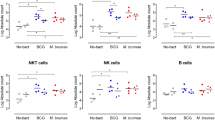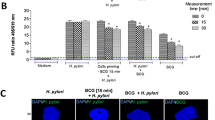Abstract
During the past decade, particular attention has been focused on treatment of bladder cancer patients with the bacterial agent bacillus Calmette-Guérin (BCG). In these studies, bladder cancer patients were instilled with BCG (75mg/50ml) once per week for 6 weeks, 1–2 weeks following trans-urethreal resection of the bladder. Cystoscopy was performed after 6 weeks and, unless tumor progression was present, monthly treatments were given for 1 year. Blood was drawn 2 h after the last instillation, and monocytes were isolated (5×106 cells/ml) and treated, or not, with lipopolysaccharide (LPS) (20 μg/ml) for tumor necrosis factor α (TNFα), interleukin-1α (IL-1α) and interleukin-6 (IL-6) release. The levels of monokines were determined by a monokine-specific enzyme-linked immunosorbent assay. Out results clearly show that, after 18 h incubation, macrophages from BCG-treated bladder cancer patients produced from 2.8- to 1.9-fold and from 2.0- to 1.3-fold greater amounts of TNFα and IL-1α respectively, compared to macrophages from healthy controls, 5-fold higher than bladder cancer patients not treated with BCG. IL-6 was not affected. In another set of experiments macrophages (5×106 cells/ml) from healthy subjects were pretreated, or not, with BCG (100 μg/ml) overnight and treated, or not, with LPS 20 μg/ml alone and in combination with interleukin-1 receptor antagonist (IL-1ra) 250 ng/ml. Macrophages treated with BCG had a strong stimulatory effect on IL-1α release (9.45 ng/ml) while LPS was less effective (3.59 ng/ml). The combination of BCG plus LPS produced an additive effect on IL-1α release (13.71 ng/ml) compared to the effect of the compound alone. The addition of IL-1ra (250 ng/ml) to BCG was not effective, while when IL-1ra was added to BCG plus LPS only a partial inhibition of IL-1α release was found (9.83 ng/ml), compared to BCG plus LPS without IL-1ra (13.71 ng/ml). These effects seem to be related to the inhibition of IL-1α stimulated with LPS, but not BCG. The priming effect of BCG exerted on LPS-stimulated monocyte production of TNFα and IL-1α from bladder cancer patients led us to study the possible modulation of fibrinogen and C-reactive protein in the serum of BCG-treated cancer patients. The plasma levels of fibrinogen and C-reactive protein were higher (approximately twice) in BCG-treated patients compared to values obtained in untreated patients or healthy controls. We conclude that the beneficial immunotherapeutic effects of BCG in bladder cancer patients are related to its capacity to prime macrophages to enhance the release of TNFα and IL-1α, but not IL-6 in response to physiological secondary stimuli, or through the direct stimulation of BCG on IL-1α or TNFα, which are directly involved in the killing of cancer cells. Moreover, the increase of IL-1α or TNFα in BCG bladder cancer patients may lead to high plasma levels of fibrinogen and C-reactive protein, two proteins responsible for the acute-phase response.
Similar content being viewed by others
References
Lamm DL, Van der Meijden APM, Morales A, Brosman SA, Catalona WJ, Herr HW et al (1992) Incidence and treatment of complications of bacillus Calmette-Guérin intravesical therapy in superficial bladder cancer. J Urol 147:596
Smith RL, Alexander RF, Aranda CP (1993) Pulmonary granulomata a complication of intravesical administration of bacillus Calmette-Guérin for superficial bladder carcinoma. Cancer 71: 1846
Brosman SA (1982) Experience with bacillus Calmette-Guérin in patients with superficial bladder carcinoma. J Urol 128:27
Haaff EO, Dresner SM, Kelley DR, Ratliff TL, Shapiro A, Catalona WJ (1985) Role of immunotherapy in the prevention of recurrence and invasion of urothelial bladder tumors: a review. World J Urol 3:76
Herr EO, Pinsky CM, Whitmore WF Jr, Sogani PC, Oettgen HF, Melamed MR (1986) Long term effect of intravesical bacillus Calmette-Guérin on flat carcinoma in situ of the bladder. J Urol 135:265
Lamm DL, Crissmann J, Blumenstein B, Crawford ED, Montic J, Scardino P, Grossmann HB, Stanisic T, Smith J, Sullivan J, Sarosdy M (1989) Adriamycin versus BCG in superficial bladder cancer: a south West Oncology Group study. In: Debruyne FMJ, Denis L, Van der Meijden APM (eds) BCG in superficial bladder cancer. Liss, New York, p 226
Van der Meijden AD PM, Van Klingeren B, Steerenberg PA, De Boer LC, De Jong WH, Debruyne FMJ (1991) The possible influence of antibiotics on results of bacillus Calmette-Guérin intravesical therapy for superficial bladder cancer. J Urol 146:444
Böhle A (1992) Prospects for improving the efficacy of BCG. Eur Urol 21 [Suppl 2]:22
Ratliff TL (1991) Bacillus Calmette-Guérin (BCG): mechanism of action in superficial bladder cancer. Urology [Suppl] 37:8
Böhle A, Newe C, Ulmer AJ, Musehold J, Gerdes J, Hofstetter AG, Flad HD (1990) Detection of urinary TNF, IL-1 and IL-2 after local BCG immunotherapy for bladder carcinoma. Cytokine 2:175
Brakenhoff JPJ, De Groot ER, Evers RF, Pannekoek H, Aarden LA (1987) Molecular cloning and expression of hybridoma growth factor inE. coli. J Immunol 139:4116
Dinarello CA (1989) Interleukin-1 and its biologically related cytokines. Adv Immunol 44:153
Conti P, Reale M, Fiore S, Cancelli A, Angeletti PU, Dinarello CA (1988) Recombinant interleukin-1 and tumor necrosis factor acting in synergy to release thromboxane, 6-keto-PGF1α and PGE2 by human neutrophils. Scand J Rheumatol [Suppl] 75:318
Conti P, Feliciani C, Barbacane RC, Panara MR, Reale M, Placido FC, Sauder DN, Dempsey RA, Amerio P (1992) Inhibition of interleukin-1β mRNA expression and interleukin-1α and α secretion by a specific human recombinant interleukin-1 receptor antagonist in human peripheral blood mononuclear cells. Immunology 77:245
Conti P, Panara MR, Porrini AM, Gambi D, Barbacane RC, Reale M, Bongrazio M, Dempsey RA (1992) Inhibition of interleukin-1 (alpha and beta), interleukin-2 secretion and surface expression of interleukin-2 receptor (IL-2R) by a novel cytokine interleukin-1 receptor antagonist (IL-1ra). Scand J Immunol 36:27
Conti P, Panara MR, Barbacane RC, Placido FC, Bongrazio M, Reale M, Dempsey RA, Fiore S (1992) Blocking the interleukin-1 receptor inhibits leukotriene B4 and prostaglandin E2 generation in human monocyte cultures. Cell Immunol 145:199
Elsässer-Beile U, Kleist S von, Stähle W, Schurhammer-Fuhrmann C, Mönting JS, Gallati H (1993) Cytokine levels in whole blood cell cultures as parameters of the cellular immunologic activity in patients with malignant melanoma and basal cell carcinoma. Cancer 71:231
Elsässer-Beile U, Kleist S von, Hölsch P, Mönting JS, Werner I (1992) Cytokine levels in whole blood cell cultures of oral contraceptive users and pregnant women. Int J Immunolpathol Pharmacol 5:185
Dinarello CA, Conti P, Mier JW (1986) Effects of purified human interleukin-α on natural killer cell activity: is fever a host defence mechanism for tumor killing. Yale J Biol Med 59:97
Depsey RA, Dinarello CA, Mier JW, Rosenwasser LJ, Allegretta M, Brown TE, Parkinson DR (1982) The differential effects of human leukocytic pyrogen/lymphocyte-activating factor, T-cell growth factor, and interferon on human natural killer activity. J Immunol 129:2504
Hannum CH, Wilcox CJ, Arend WP, et al. (1990) Interleukin-1 receptor antagonist activity of a human interleukin-1 inhibitor. Nature 343:336
Moore M (1989) Cancer and immunology. Curr Opin Immunol 1:861
Gagnon L, Filion LG, Rola-Pleszczynski M (1989) Enhanced production of tumor necrosis factor (TNF)-alpha by human monocytes exposed to leukotriene B4. Int J Immunopathol Pharmacol 2:155
Carswell EA, Old IJ, Kassel RL, Green S, Fiore N, Williamson D (1975) An endotoxin induced serum factor that causes necrosis of tumors. Proc Natl Acad Sci USA 72:3666
Balkwill FR, Burke F (1989) The cytokine network. Immunol Today 10:299
Dinarello CA, Bernheim HA (1985) Ability of human leukocyte pyrogen to stimulate brain prostaglandin synthesis in vitro. J Neurochem 37:702
Ramadori G, Sipe JD, Dinarello CA, Mizel SB, Colten HR (1985) Pretranslational modulation of acute phase hepatic protein synthesis by murine recombinant interleukin-1 (IL-1) and purified human IL-1. J Exp Med 162:930
Boyum A (1968) Isolation of mononuclear cells and granulocytes from human blood. Scand J Clin Invest 21:225
Gordon AH, Koj A (1985) The acute phase response to injury and infection. Elsevier, Amsterdam, pp 1–339
Mackiewicz A, Speroff T, Ganapathi MH, Kushner I (1991) Effects of cytokine combinations on acute phase protein production in two human hepatoma cell lines. J Immunol 146:3032
Morales A, Eidinger D, Bruce AW (1976) Intracavitary bacillus Calmette-Guérin in the treatment of superficial bladder tumors. J Urol 116:180
Herr HW, Pinski CM, Whitmore WF Jr, Oettgen HF, Melamed MR (1983) Effect of intravesical bacilus Calmette-Guérin (BCG) on carcinoma in situ of the bladder. Cancer 51:1323
Lamm DL, Blumenstein BA, Crawford ED, Montie JE, Scardino MF, et al. (1991) A randomized trial of intravesical doxorubicin and immunotherapy with bacillus Calmette-Guérin for transitional-cell carcinoma of the bladder. N Engl J Med 325:1205
Sugarman BJ, Lewis GD, Eessalu TE, Aggarwal BB, Shepard HM (1987) Effects of growth factors on the antiproliferative activity of tumor necrosis factor. Cancer Res 47:780
Aggarwal BB, Eessalu TE (1987) Effects of phorbol esters on down regulation and redistribution of cell surface receptors for tumor necrosis factor-α. J Biol Chem 262:16450
Jelinek DF, Lipsky PE (1987) Enhancement of human B cell proliferation and differentiation by tumor necrosis factor-α and interleukin-1. J Immunol 139:2970
Philip R and Epstein LB (1986) Tumor necrosis factor as immunomodulator and mediator of monocyte cytotoxicity induced by itself, γ-interferon and interleukin-1. Nature 323:86
O'neal LAJ, Bird TA, Saklatvala J (1990) How does interleukin-1 activate cells? Immunol Today 11:392
Saklatvala J, Guesdon F (1992) Interleukin 1 and tumor necrosis factor signal transduction mechanism: potential targets for pharmacological control of inflammation. J Rheumatol 19:65
Arend WP, Welgus HG, Thompson RC, Eisenberg SP (1990) Biological properties of recombinant human monocyte-derived interleukin-1 receptor antagonist. J Clin Invest 85:1694
Beutler B, Milsark IW, Cerami A (1985) Passive immunization against cachectin/tumor necrosis factor protects mice from lethal effects of endotoxin. Science 229:869
Mathison JC, Wolfson E, Ulevitch RJ (1988) Participation of tumor necrosis factor in the mediation of gram negative bacterial lipopolysaccharide-induced injury in rabbits. J Clin Invest 81: 1925
Zhang X, Morrison DC (1993) Pertussis toxin-sensitive factor differentially regulates lipopolysaccharide-induced tumor necrosis factor-α and nitric oxide production in mouse peritoneal macrophages. J Immunol 150:1011
Steinhauer EH, Doyle AT, Kadish AS (1985) Human natural killer cytotoxic factor (NKCF): role of TNFα J Immunol 135:294
Author information
Authors and Affiliations
Rights and permissions
About this article
Cite this article
Conti, P., Reale, M., Nicolai, M. et al. Bacillus Calmette-Guérin potentiates monocyte responses to lipopolysaccharide-induced tumor necrosis factor and interleukin-1, but not interleukin-6 in bladder cancer patients. Cancer Immunol Immunother 38, 365–371 (1994). https://doi.org/10.1007/BF01517205
Received:
Accepted:
Issue Date:
DOI: https://doi.org/10.1007/BF01517205




